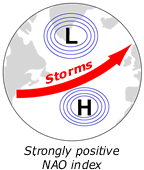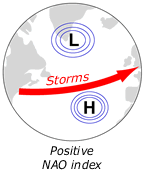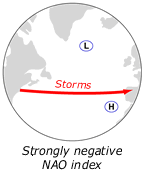Environmental Prediction in the Gulf of Maine
Forecast of North Atlantic right whale births
The North Atlantic Oscillation (NAO) is a natural fluctuation in the atmosphere




The North Atlantic Oscillation (NAO) is a natural fluctuation in the atmospheric pressure difference between the Icelandic Low and Azores High cells. It is similar to El Niño, its more famous "cousin" in the Pacific Ocean. Like El Niño, the NAO greatly affects weather patterns. The red arrow represents the strength and direction of storms crossing the Atlantic. A thicker red arrow denotes stronger storms in a more northerly direction. A thinner red arrow denotes weaker storms in a more easterly direction.
Measured with the NAO index
The status of the NAO is measured with the NAO index. The index indicates the relative difference between the Icelandic Low and Azores High. A positive NAO index indicates a strong difference, and a negative NAO index indicates a weak difference. Positive or negative NAO phases may persist for several years, and decades may be predominantly one phase or the other. The NAO strongly affects ocean currents in the North Atlantic and weather in Europe and North America.

Right whale model uses Winter Station-Based NAO Index
The model for forecasting right whale calving uses the Winter (December-March) Station-Based NAO Index provided by Dr. James Hurrell of the National Center for Atmospheric Research. This index is calculated based on the difference of normalized sea-level pressure between Lisbon, Portugal, and Stykkisholmur/Reykjavik, Iceland, since 1864. Positive values of the index indicate stronger-than-average westerlies over the middle latitudes. Hurrell obtained station data from the World Monthly Surface Station Climatology.
NAO influences strength and direction of winds and currents
When the NAO index is positive:
- High and low pressure cells are strong.
- Westerlies strengthen and shift north.
- Strong winds blow over the northeast Atlantic Ocean.
When the NAO index is negative:
- High and low cells weaken and shift.
- Westerlies shift south.
- Strong winds blow over the central Atlantic.
Changes in the winds cause shifts in the strength and direction of ocean currents in the North Atlantic, including deep currents that flow into the Gulf of Maine through the Northeast Channel.


